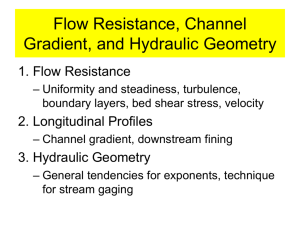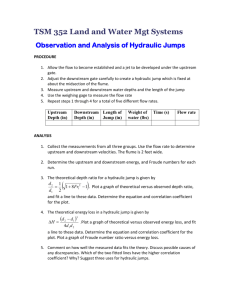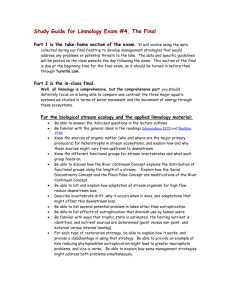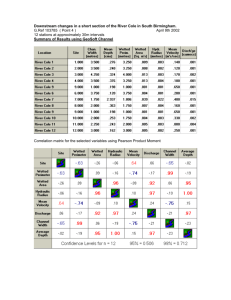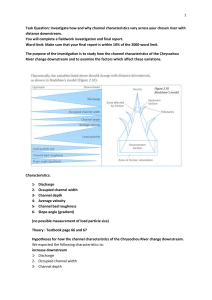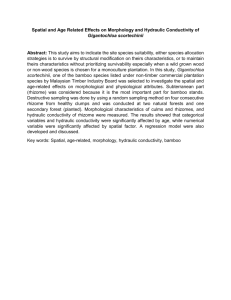Introduction1
advertisement
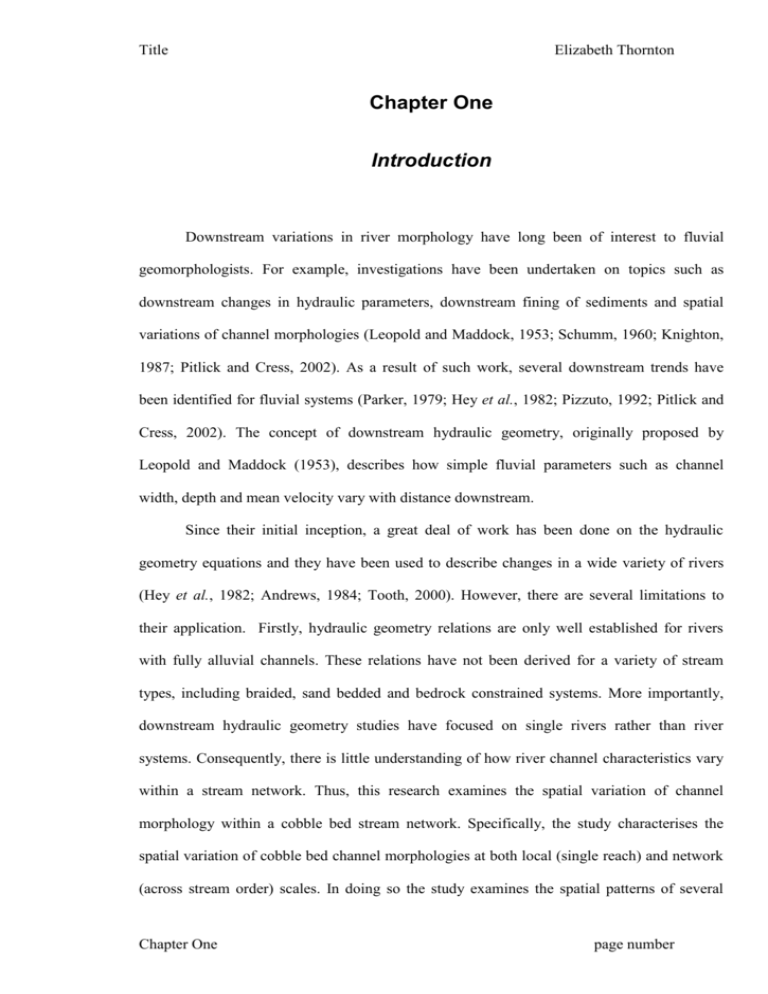
Title Elizabeth Thornton Chapter One Introduction Downstream variations in river morphology have long been of interest to fluvial geomorphologists. For example, investigations have been undertaken on topics such as downstream changes in hydraulic parameters, downstream fining of sediments and spatial variations of channel morphologies (Leopold and Maddock, 1953; Schumm, 1960; Knighton, 1987; Pitlick and Cress, 2002). As a result of such work, several downstream trends have been identified for fluvial systems (Parker, 1979; Hey et al., 1982; Pizzuto, 1992; Pitlick and Cress, 2002). The concept of downstream hydraulic geometry, originally proposed by Leopold and Maddock (1953), describes how simple fluvial parameters such as channel width, depth and mean velocity vary with distance downstream. Since their initial inception, a great deal of work has been done on the hydraulic geometry equations and they have been used to describe changes in a wide variety of rivers (Hey et al., 1982; Andrews, 1984; Tooth, 2000). However, there are several limitations to their application. Firstly, hydraulic geometry relations are only well established for rivers with fully alluvial channels. These relations have not been derived for a variety of stream types, including braided, sand bedded and bedrock constrained systems. More importantly, downstream hydraulic geometry studies have focused on single rivers rather than river systems. Consequently, there is little understanding of how river channel characteristics vary within a stream network. Thus, this research examines the spatial variation of channel morphology within a cobble bed stream network. Specifically, the study characterises the spatial variation of cobble bed channel morphologies at both local (single reach) and network (across stream order) scales. In doing so the study examines the spatial patterns of several Chapter One page number Title Elizabeth Thornton geomorphic features; the form of the channel at different reach scales, variation of bedforms within reaches and the spatial variation of sediment characteristics within the network. These processes controlling these geomorphic features are considered in their local (reach) context and in relation to their potential to scale up with the river network. This work is then placed within the context of previous studies into downstream hydraulic geometry. The study was carried out in Kangaroo Valley, located in the southern highlands of New South Wales, Australia. Channel form analyses were performed at sites on the major river within the valley, namely the Kangaroo River, and three of its tributaries. All reaches examined within the study were dominated by large cobble to boulder sized sediments, making them ideal for consideration within this study. 1.1 Aims and hypothesis The main objective of this project is to identify downstream variations in the channel morphology of a cobble bed river network and to link these changes to controlling variables. In achieving this objective the thesis will: compute trends that demonstrate the potential of hydraulic geometry parameters to scale up within the Kangaroo Valley stream network. assess the morphological variance within and between reaches; and determine whether the extent of spatial variability within reaches is consistent across scales. It is hypothesized that downstream relationships for channel morphology in cobble bed streams differ from those in gravel bed streams. This is attributed to the larger bed material in cobble streams inhibiting the ability of such rivers to adjust their forms under natural flow conditions. Therefore, the downstream hydraulic geometry equations observed in the Kangaroo River system should differ from those reported elsewhere. However, despite the Chapter One page number Title Elizabeth Thornton impact of coarse sediment on downstream hydraulic geometry relationships, it is expected that channel morphologic variables will scale up within a network in a similar manner to the way in which previously documented hydraulic geometry parameters scale up with increasing distance downstream. The findings of this study will have several important implications for the field of fluvial geomorphology. Initially, it will yield valuable information on the application of hydraulic geometry in stream networks, improving the understanding of stream network functioning. A thorough knowledge of stream networks is becoming increasingly important in light of recent developments in catchment modelling. The predictive power of many hydrologic models will be improved if techniques can be developed to properly parameterize the spatial variability of the morphometric variables in these models (Moody and Troutman, 2002). In addition, this study is examining a river system type that has not received much attention in the literature. Cobble bed rivers are common in both high relief regions and in the headwater zones of most stream systems and, consequently, understanding how these rivers behave will aid in the derivation of more comprehensive catchment wide models. 1.2 Thesis overview This study provides a detailed examination of the relationship between channel form (bankfull width/channel depth) and scale in a cobble bed river system. is organised as follows:Chapter Two describes previous research carried out in river systems, providing context for the study. Chapter Three presents regional and local descriptions of the study sites, including information on landforms, geology, climate and vegetation, and outlines the field work and analytical methodologies undertaken in this project. Chapter Four presents the results of the field work, including a river network analysis, while Chapter Five discusses and Chapter One page number Title Elizabeth Thornton compares the results to downstream relationships defined in the gravel bed river literature. The thesis is then concluded in Chapter Six with a summary of the research findings. Chapter One page number

